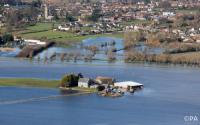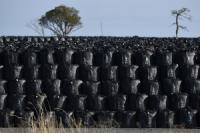-
Training cybersecurity professionals to protect critical infrastructure
Idaho National Laboratory and the Department of Homeland Security (DHS) announce the successful completion of the 100th iteration of the Industrial Control Systems Cybersecurity (301) training course; a course tailored to defending systems used across the critical infrastructure sectors. Since April 2007, over 4,000 cybersecurity professionals have participated in the advanced course.
-
-
Replacing coal with solar will save lives, money
Tens of thousands of Americans die prematurely each year from air pollution-related diseases associated with burning coal. By transitioning to solar photovoltaics (PV) in the United States, up to 51,999 American lives would be saved at $1.1 million invested per life. To fully replace all the coal production in the United States with solar PV, it would take 755 gigawatts—a significant increase compared to the 22.7 gigawatts of solar installed in the United States currently.
-
-
Seacoast roads under new threat from rising sea level
Research has found that some roads, as far as two miles from the shore, are facing a new hazard that currently cannot be seen by drivers - rising groundwater caused by increasing ocean water levels. Without drastic improvements to these routes, at or below the pavement surface, motorists can expect segments of these roadways to deteriorate more quickly, require more maintenance and be closed for longer periods of time.
-
-
Taller wind turbine towers to help expand wind energy nationwide
Winds at higher elevations, generally, are stronger and more consistent, even in wind-rich states such as Iowa and Texas. In fact, a 20-meter increase (about 66 feet) in tower height creates a 10 percent boost in Iowa energy production. Researchers have been working on developing new concrete tower technology capable of reaching 140 meters (about 459 feet). The towers will be assembled from precast panels and columns made with high-strength or ultra-high-performance concrete. Those panels and columns can be cast in sizes that are easy to load on trucks. They are tied together on-site by cables to form hexagon-shaped cells. A crane can stack the cells to form towers as high as 140 meters.
-
-
Budget proposal calls for abolishing the Chemical Safety Board
Under President Donald Trump’s proposed 2018 budget, the world’s only independent body dedicated to investigating chemical-related industrial accidents would be abolished. A story in Chemical & Engineering News (C&EN), the weekly newsmagazine of the American Chemical Society, revisits why the U.S. Chemical Safety & Hazard Investigation Board was initially created, its accomplishments, and what experts say about its potential demise.
-
-
Frequency of coastal flooding will double globally in next decades

The frequency and severity of coastal flooding throughout the world will increase rapidly and eventually double in frequency over the coming decades even with only moderate amounts of sea level rise, according to a new study. The new report shows that with just 10 to 20 cm (4 to 8 inches) of sea level rise expected no later than 2050, coastal flooding will more than double. This dramatic increase in coastal flooding results from rising sea levels combined with storm-driven flooding, including the effects of waves and storm surge.
-
-
No funds for California's earthquake early-warning system in Trump's proposed budget
The Trump administration’s proposed budget would eliminate federal funding for an earthquake early warning system being developed for the U.S. West Coast. Critics say that if the relevant clauses in the budget proposal become law, the long-planned seismic warning effort will be killed. Scientists say the withdrawal of federal funds would likely end the early-warning project, which aims to send smartphone tremor alert messages to West Coast residents.
-
-
Strong carbon price needed to drive large-scale climate action: Economists
Meeting the world’s agreed climate goals in the most cost-effective way while fostering growth requires countries to set a strong carbon price, with the goal of reaching $40-$80 per ton of CO2 by 2020 and $50-100 per ton by 2030. This is the key conclusion of the High-Level Commission on Carbon Prices, led by Nobel Laureate Joseph Stiglitz and Lord Nicholas Stern. The study concludes that a well-designed carbon price is an indispensable part of a strategy for efficiently reducing greenhouse gas emissions while also fostering growth.
-
-
Argonne’s nuclear security training team has a global reach
At Argonne National Laboratory, a team of experts is training foreign scientists and engineers in the peaceful uses of nuclear energy and technology. Although the building is more than 4700 miles from the headquarters of the International Atomic Energy Agency (IAEA) in Vienna, the team is helping it uphold decades of international nuclear cooperation. Over the years, Argonne has taught more than 220 courses to more than 5,000 students, many of whom became leaders of nuclear safety and security abroad.
-
-
U.S. nuclear watchdog greatly underestimates potential for nuclear disaster

The U.S. Nuclear Regulatory Commission (NRC) relied on faulty analysis to justify its refusal to adopt a critical measure for protecting Americans from the occurrence of a catastrophic nuclear-waste fire at any one of dozens of reactor sites around the country, a new study shows. Fallout from such a fire could be considerably larger than the radioactive emissions from the 2011 Fukushima accident in Japan. These catastrophic consequences, which could be triggered by a large earthquake or a terrorist attack, could be largely avoided by regulatory measures that the NRC refuses to implement.
-
-
Tornado damage impact could triple in coming decades

Tornadoes are one of the most unpredictable weather phenomena on Earth. Each year the United States, home to more tornadoes than any other country, sustains billions of dollars of damage, death, injuries, and disruption from the violent storms. Scientists say that the potential for annual tornado impact magnitude and disaster could triple by the end of the twenty-first century.
-
-
New funding enables work on Internet policy and cybersecurity for key infrastructure
MIT’s cross-disciplinary Internet Policy Research Initiative (IPRI) announced that it has awarded $1.5 million to a select group of principal investigators for early-stage Internet policy and cybersecurity research projects. “Understanding the nuance of cybersecurity risk in our critical infrastructure will help policymakers assure that the proper incentives are in place to reduce the threat of catastrophic attacks,” says IPRI founding director Daniel Weitzner.
-
-
The Hindenburg: It was not hydrogen's fault!
Eighty years ago this month, on 6 May 1937, the German passenger airship LZ 129 Hindenburg caught fire and was destroyed as it was attempting to dock with its mooring mast at Naval Air Station Lakehurst in Manchester Township, New Jersey. Current information indicates that it was not the gas but a coating on the dirigible’s skin that was primarily responsible for the disaster.
-
-
New tool could help predict, prevent surging waters in flood plains
A group of international scientists studying China’s Yellow River has created a new tool that could help officials better predict and prevent its all-too-frequent floods, which threaten as many as eighty million people. The tool — a formula to calculate sediment transport — may also be applied to studying the sustainability of eroding coastlines worldwide.
-
-
Right research, development investments “good bets” for both climate and economies
Investing in new ways of utility-scale electricity storage and capturing carbon to store underground should be a priority for governments aiming to meet the greenhouse gas and “green energy” targets set out in the Paris Agreement despite shrinking research and development budgets, experts suggest. Researchers analyzed a range of studies and expert reports on public energy R&D investments to uncover common threads and trends — pulling together the current state of knowledge on cost-effective investments across a range of energy technologies.
-
More headlines
The long view
Helping Strengthen America’s Critical Infrastructure
Everyday life depends on a robust infrastructure network that provides access to running water, communications technology and electricity, among other basic necessities. The experts who keep our national infrastructure secure and resilient also need a strong network to share their knowledge and train the next generation of professionals capable of solving complex infrastructure challenges.
AI and the Future of the U.S. Electric Grid
Despite its age, the U.S. electric grid remains one of the great workhorses of modern life. Whether it can maintain that performance over the next few years may determine how well the U.S. competes in an AI-driven world.
Using Liquid Air for Grid-Scale Energy Storage
New research finds liquid air energy storage could be the lowest-cost option for ensuring a continuous power supply on a future grid dominated by carbon-free but intermittent sources of electricity.
Enhanced Geothermal Systems: A Promising Source of Round-the-Clock Energy
With its capacity to provide 24/7 power, many are warming up to the prospect of geothermal energy. Scientists are currently working to advance human-made reservoirs in Earth’s deep subsurface to stimulate the activity that exists within natural geothermal systems.
Experts Discuss Geothermal Potential
Geothermal energy harnesses the heat from within Earth—the term comes from the Greek words geo (earth) and therme (heat). It is an energy source that has the potential to power all our energy needs for billions of years.
